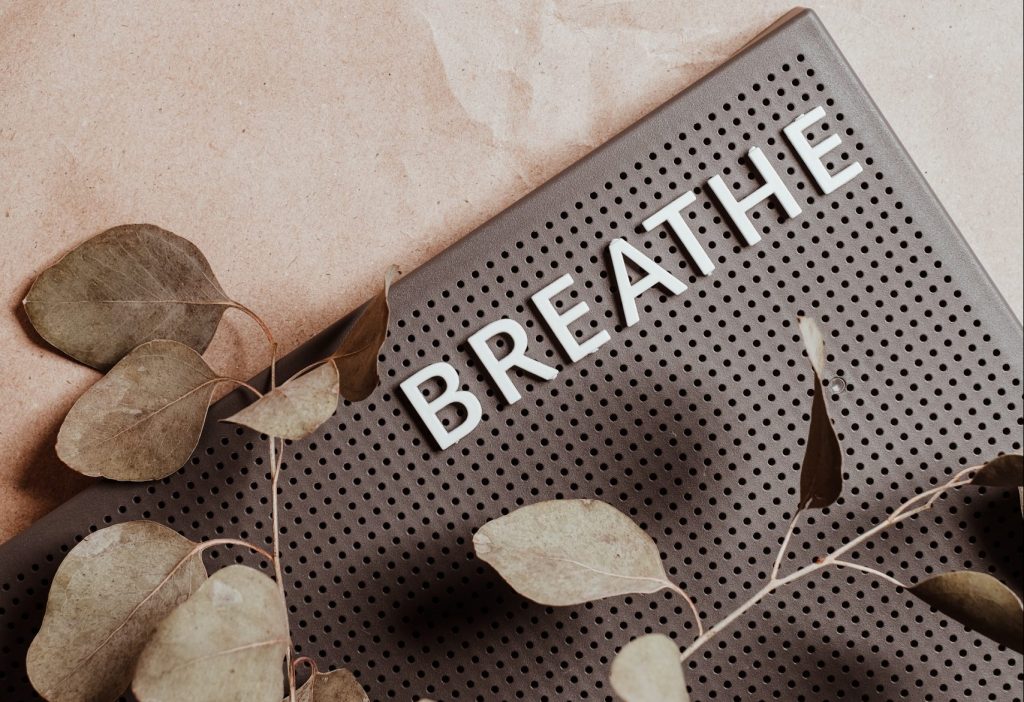
It’s All In Your Breath
- Post author:admin
- Post published:July 8, 2022
- Post category:Lifestyle / Uncategorized / Wellbeing
- Post comments:0 Comments
We all know how amazing it feels to let out a long exhale…
Drop those shoulders…
and let all the stress slip away!

Breathing for relaxation and stress reduction is so very important, but did you know there are many things in the winter months that can unknowingly increase your stress? This makes breath practice the perfect winter activity!
Let’s look at how these affect our breath and how to combat these seasonal stressors:
- Winter often means time inside the house
While home is our safe and comfy place, there are drawbacks to long hours on the lounge in your Oodie! The air quality inside our houses is not as good as outside air (at least in our beautiful country). This means we have more exposure to airborne toxins and this is especially relevant after all the rain and increased mould growth. Our windows tend to be shut down and the horrible fact is that we have a greater opportunity to breathe in dust, dust mites, pest droppings, mould, recycled toxins from cleaning products and personal care products. This is a source of exposure that boosts stress hormones, affects breathing, and increases risk of illness. Proper breathing can help here.
- Winter usually means we are more sedentary
Spring and summer are the time we love to get outdoors, to the beach, to the park and move our bodies – naturally generating endorphins, happy hormones and detoxifying our bodies with movement. This doesn’t happen as much in winter, so reducing stress and managing our mood through breath work is so helpful
- Screen time and blue light exposure goes up in winter
Less hours of sunlight basically means more hours under blue light emitting LED or fluro lights. It means more time in front of our computers or TV screens. The blue light exposure we get in winter can really increase the production of stress hormones, affect our sleep and create a higher risk of issues like sadness or seasonal affective disorder.
Let’s combat this by shaking off or reducing stress inputs with our breath. This is exciting because there is so much evidence here. Read on to learn how to breathe away winter, breathe away stress, and feel better overall!
The Basics
Breathing is the biggest opportunity we have to manage our well-being. Just as your heart beats constantly, we breathe every minute of every day for our entire life. When we don’t breathe well there are significant health impacts on every bodily system. But because we breathe so often, every breath is an opportunity to support our wellbeing.
Regulating and restoring functional breathing can literally change every cell in your body as well as have a powerful impact on your emotions – mindfulness meets medicine!
Let’s get a little sciency…
Over breathing is a major source of dysfunction in our modern world.
We over breathe when we are exposed to physical or emotional stress and to add to that, we are often mouth breathing.
It is estimated that many of us breathe up to 15L of air per minute instead of a healthy 5-6L per minute. What this means is that we shift our carbon dioxide and oxygen levels in a way that works against us.
Carbon dioxide is actually a really important gas – it helps regulate our immune system, relaxes our blood vessels reducing high blood pressure, prevents fatigue, supports sleep and helps us concentrate. The more you breathe per minute, the more of this gas you lose to the atmosphere.
One of the ways to help rebalance the carbon dioxide levels in your blood is to breathe exclusively through your nose. This naturally prevents overbreathing and has so many other benefits for whole body health.
Your nose knows!
Breathing through the nose is where it’s at and there are some super simple reasons:
- Your nose and sinus act to warm the air you breathe in. This is especially important in the winter as cold air can be a major cause of irritation to your throat and lungs, exacerbating conditions such as asthma and the flu.
- As you breathe through your nose, the air is humidified to the optimal level for your lungs. In this way it prevents irritation in much the same way warming the air does.
- It filters out particulates and toxins. Your nose and sinus are full of lymph tissue that filters out toxins.
- Reduces excess air flow in day and increases airflow at night
- Produces nitric oxide. On a long slow breath, you take this amazing molecule into your airway and deep into your lungs, relaxing lung tissue and your entire vascular system. This can be beneficial for your blood pressure too. Nitric oxide builds up in your sinus between breaths and is one benefit of slow breaths. Always breathe in through the nose to get a dose of nitric oxide delivered into your airway.
The long slow exhale
There is so much power in a lengthened, slow exhale. Your heart rate drops and you activate your relaxation system. Do this a couple of times every day to start switching your body back into relaxation mode.
Start by slowing down your breathing, then breath out for 1 or 2 counts longer than your in breath. Switch the focus of your breathing from the chest to the abdomen. That’s right, let your lower belly pop out and take the breath! Slow abdominal breathing is a commonality among all traditions such as yoga, zen and modern techniques such as Buteyko.
Long slow breaths have been shown in the research to improve your heart rate variability (HRV) and move your body across from ‘fight or flight’ into ‘rest and digest’ mode. Improved HRV indicates you are more easily able to flip over into a relaxation state and recover better from things such as stress or exercise.
Now that we have worked out HOW to breathe, let’s look at WAYS to breathe.
There are lots, here are a few, but the main thing is to find one that works for you.
- Box Breathing – this technique aims to regulate and slow the breath. It’s great for people that prefer to focus on the task and rhythm of the breath, and to prevent distraction. It’s super simple.. Breath in, hold, breath out, hold, breath in, hold and so on. Do this for a count that is comfortable for you – a count of 4 or 5 is best, but as you get better you can extend this out to 6 or 7. Complete 4 rounds and you have completed your box breathing
- Extended exhale – with all the benefits listed above, it’s a great idea to sit and take some slow breaths with an extended exhale. If you breathe in for 3, then out for 5. Like box breathing, you can lengthen and slow down your technique. Don’t forget to use your belly and keep the chest still.
- Small breath holds – small breath holds are a great way to slow down the breath and you can do it anywhere. In front of the TV, in the car or even on the toilet. Simply breathe in through the nose, hold for 3 seconds and breathe out through the nose. Do this in a round of 3 breaths and then return to normal breathing. This is great to build your nasal breath habit, slow the breath rate and trigger a relaxation response. It also helps to deliver nitric oxide into your lungs as it builds up in your sinus during the breath hold. Nitric oxide will help with your lung health and relaxation of your airways.
- Diaphragmatic breathing versus chest and thoracic breathing. This is an easy one to practice at home, and for those of you who feel you need some real TLC, or some foundational practice, this is the best start point. Lay on the floor with knees up and place a small paperback onto your lower belly. You know you are belly breathing when your chest is still and your diaphragm is doing the work of breathing, lifting the book up and down as you breathe. Do this a couple of times per day until you feel sure you are not using your upper chest to drive your breath, but rather your diaphragm.
And WHERE to breathe
Well, that sounds like a silly heading! But really, there are lots of great opportunities.
- Ever been on hold to the phone company, or the bank? This is a great time to drop the frustration and practice some breathing. Put your phone on speaker, put it on the table and start a few minutes of breath work.
- In the car – now this is where you are your own captive audience. How many hours do we spend in the car each week? That a LOT of fantastic breathing time. Driving is another stressor and you can counter that by breathing it away, literally!
- In bed before you sleep
- At the dinner table before you eat
- While watching TV in the evening
- In nature
You can see where I’m going here?!?! You breathe every minute of every day and it provides us with endless opportunities to build a body that is resilient to stress but also has a MEMORY for relaxation. Whether we are using our stress system or our relaxation system – the one we use most is the one our body defaults to in subconscious moments. Best to help your body automatically revert to relaxation. The other option is chronic stress where you feel constantly wired, even in the absence of stressful stimuli! This is totally under your control. The more you walk the path, the clearer and easier the path is to navigate!

A few of our favourite oils to level up your breath work
You can use an essential oil each time you do breathwork. Simply pop a couple of drops on your palms and cup your hands over your nose for those deep breaths and low slow exhales. This is a beautiful and POWERFUL option as you will link that feeling of relaxation into the smell of the oil. Anytime you use the oil it will transport your nervous system back to that relaxed state!
iKOU – Essential Oil – Lemon Myrtle
Great for a physical and emotional cleanse, lemon myrtle can also be calming, improving concentration and acting as an antidepressant, it can build feelings of happiness and help with relaxation.
Aromatherapy Pulse Point Oil – Tension Tonic
This potent blend showcases the natural fragrances of Australian peppermint and lavender and can be used to soothe and relieve the symptoms of muscle tension and headaches.
Aromatherapy Pulse Point Perfume Oil – Captive
A restorative Unisex blend of spice, wood, and citrus, which is refreshing, stimulating, and uplifting.
Dindi Naturals Pure Essential Oil – Beautiful Blend
A fresh, exotic citrus blend to boost feelings of wellbeing, confidence and desire. Contains essential oils of frankincense, rosalina, mandarin, neroli and lime.
In a nutshell
Breathing really is the most powerful way to take control of your physiology and your emotions. You can do it anywhere, anytime.
- Breathe through your nose at all times for the best respiratory health and reduced toxin exposure
- Lengthen your exhalation to activate your relaxation arm of your nervous system. This is where healing, digestion and rebuilding occurs
- Do some breath work before each meal to assist with digestion and nutrient absorption
- Combine your breath work with some beautiful oils to support your nervous system even more.
Happy Days!
References
Longer Exhalations Are an Easy Way to Hack Your Vagus Nerve
The Relaxation Response: Psychophysiologic Aspects and Clinical Applications
Breath of Life: The Respiratory Vagal Stimulation Model of Contemplative Activity





